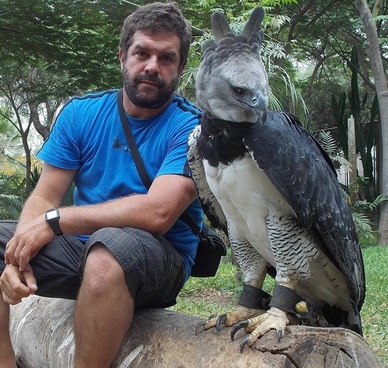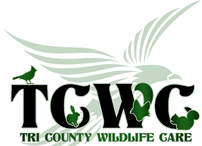 One of the most beautiful animals I have seen. This is Antonio Fernandini Guerrero with his harpy eagle he nursed back to health after it was shot. It is blind in one eye, and unfortunately cannot be released back in the wild. If you would like to learn more about Antonio and his work with the Harpy eagle, please feel free to contact him. He works with raptors in general. My friend Cassandra Caroline Živka Suština is putting together a Go Fund Me campaign to help Antonio with meat costs for his eagles, and to hopefully start working on building a larger enclosure and flight runs for the eagles. Once the campaign is up and running, I will post it here. P.S. This photo is genuine and not photoshopped. This particular harpy eagle is a female, and about 20 pounds with a 6.5 foot wingspan. Did you know? Harpy Eagles are among the world’s largest and most powerful eagles. Their rear talons are about 3-4 inches long – the same size as a grizzly bear’s claws! Like many other birds of prey, Harpy Eagles continue to bring fresh green twigs and branches to the nest after the chick has hatched. Some researchers think this helps keep insects and parasites away and provides a cooler environment for the nestling. A female can weigh up to two times more than her mate. Deforestation and shooting are the two main threats to the survival of Harpy Eagles. Plumage: The harpy eagle has dark gray feathers with a white underside. A black band of plumage spans its neck and a fan of gray feathers crowns its head. Male and female plumage is identical. Diet: A hunting carnivore and an apex predator, the harpy eagle preys primarily on tree-dwelling mammals like sloths, monkeys, and opossums. They will occasionally prey on other birds like macaws, and on reptiles like iguanas. Females generally target larger prey because of their size, leaving smaller prey for the males. Habitat: The birds live in the rainforests of Central and South America. They prefer large expanses of uninterrupted forest and spend the majority of their time in the forest canopy. They are rarely seen flying over the canopy or in open spaces. Geography: The harpy eagle is found primarily in South America, in countries like Brazil, Ecuador, Guyana, Suriname, French Guiana, Colombia, Venezuela, Bolivia, Paraguay, Peru, and northeast Argentina. The species is also found in areas of Mexico and Central America, though the populations are far smaller. Lifespan: The bird’s lifespan is believed to be 25-35 years. Social Structure and Breeding: Harpy eagles mate for life. Large nests made of sticks and branches and lined with softer materials are built at least 90 feet from the ground in huge trees like the kapok tree, the Brazil nut tree, or the Cambara tree. The harpy couple often reuses the same nest over many years. The female lays two eggs, but once the first egg hatches, the remaining egg is ignored and will not hatch. Both parents spend all their time protecting and raising the chick until it fledges, usually within 6 or 7 months, though it returns to the nest over the next 6-10 months for an occasional free meal. A harpy pair will produce a chick every 2-4 years. Young harpy eagles reach sexual maturity between the ages of 4 and 5. See more at: http://www.peregrinefund.org/explore-raptors-species/Harpy_Eagle#.dpuf
24 Comments
Sagar sharma
6/16/2019 07:38:20 am
I loved your work keep going
Reply
Bobbi jo
12/5/2019 07:17:30 pm
Until today I had no idea there was an Eagle like this. My friend posted it on Facebook. I loved reading about this beautiful bird and thank you for the enlightenment and education♥️
Reply
Barbara Lemanski
3/1/2023 03:45:36 pm
So sorry this bird doesn't have freedom and is a spectacle. I wish it freedom to enjoy its life.
jean lehrman
10/1/2019 10:15:14 am
i am looking for an animal refuge of any kind where i
Reply
Tonya McCommas
10/21/2022 02:32:15 pm
I think it's wonderful you want to work with nonhuman creatures, especially during the last part of your life. I don't know how to reach organizations with the Harpy Eagle, but, you can reach out to organizations that are local that handle predator birds how have been injured and need therapy and handling till they recover. These organizations could use volunteers to help.
Reply
John Anderson
11/26/2019 09:21:22 am
Antonio
Reply
12/1/2019 11:26:59 pm
May God protect your bright joyful goal to keep such beautiful animal safe. I’d love to donate and share your go fund me because it’s proper for such great work,
Reply
Nicole Dotson
12/4/2019 02:29:08 pm
Antonio
Reply
Kimberly Turner
12/10/2019 06:33:35 pm
Absolutely wonderful. Awesome 😍. My mouth is still open. I am a bird lover but the Harpy Eagle just became my favorite. Thanks for sharing.
Reply
Rick Perkins
12/22/2019 07:21:42 am
Thanks for helping animals. There is a special place for people like us after death.
Reply
Blue
1/11/2021 02:33:42 pm
You should refer to female animals as "she" not "it." This is such a disturbing trend, erasing the feminine in nature, that I knew the bird was female simply because you said "it" instead of "he."
Reply
Topaz
2/13/2022 09:19:45 am
Get over it!!
Reply
Turule
7/10/2023 12:14:14 am
Lmao!! Right?! Who has time to complain about the pronouns of animals..such a silly time we live in.
yo yo
5/12/2021 07:07:51 pm
i need the name of the guy i need an interview on harpy eagles
Reply
Barbara Bishop
1/28/2022 04:59:04 am
My late husband Rex nursed a Harpy eagle back to health when he was a teenager living in West TX. Said he had to release it when neighborhood pets started "disappearing".
Reply
Sassy
4/11/2022 01:30:33 am
Why does that poor thing have such huge chains around her ankles...i hope they are not on her all the time
Reply
David
8/29/2022 01:39:01 am
Those aren't chains (though I think I take your meaning behind it), those are most likely leather anklets. They're very soft and they don't hurt the animals if they're worn correctly. They can be attached to a jess to tether the bird. At first this probably sounds cruel, leashing a wild animal that wants to roam. But this is necessary with wild birds of prey, to protect the injured birds from further injuring themselves, and to protect the people from the birds. Judging from the size of that Harpy eagle, I feel like she could probably pretty easily kill that man.
Reply
Maggie
11/15/2022 10:08:12 am
I wonder whether “Sassy” even read that the beautiful bird had been shot and that she was blind in one eye.
Olympia Morrison
1/29/2023 05:43:29 am
Have you taken it out it's shackles yet?.
Reply
Rena G
4/10/2023 06:04:39 pm
To those criticizing the teathers, do you know anything about birds? Did you even read the article? She would starve if released into the wild since she had been shot and is blind in an eye. If you care about her welfare donate money to build her a larger enclosure for her to fly and live in. But no people like this just like to complain. they never read anything, research, or lift a finger to help. She is helping raise awareness for her species, and is living a good life where she is fed and cared for. Thank you for your hard work!
Reply
Tracy
2/23/2024 03:54:11 pm
Very well said&great suggestions!!! #awareness
Reply
Bill
5/22/2023 08:05:29 am
People do not understand the good that other people do and the restoration of forests the conservation of animals and the recovery of animals. All they see is there shallow view of what is in front of them and thinks that they want to make a difference because they never know the truth or they never research it enough to understand. I think you're doing a wonderful job and would love to help In any way that I can. Blessings
Reply
Mikell
10/6/2023 06:31:50 pm
Harpys are so cool. Noticeably thicker and heavier than pretty much any other raptor. Like friggin flying tanks.
Reply
Judy E
12/14/2023 06:12:46 pm
Thank you so much for rehabilitating this magnificent creature! I’d never heard of a Harpy Eagle until today! They’re beautiful and I love ❤️ that you’re doing all you can to help them. ☮️
Reply
Leave a Reply. |
Archives
April 2024
Welcome!PawsPartners.org is an alliance formed between A-PAL Humane Society of Amador County and Tri County Wildlife Care, the latter serving native wildlife in Amador, Calaveras, and Eastern San Joaquin Counties. Since inception we have added the Shelter Partners volunteer group, who support our local Animal Control organization, and Amador County Animal Response Team (ACART). Categories
All
|
 RSS Feed
RSS Feed

